  |  | |||||
| |||||||||||||||
Sculpture timber durability |
||||
Durability of Timber in Relation to Sculptures |
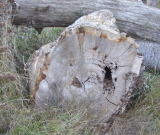 |
|||||||||||||||||||||||||||||||||||||||||||||||||||||||||||||||||||||||||||||||||||||||||||||||||||||||||||||||||||||||||||||
How long will a timber sculpture last outdoors before it rots away? A very common question. The rate at which a timber sculpture rots away is broadly dependent on the species of timber, the environment in which it is kept, and the preservative treatment it has received. Timber that is generally available in the UK is the subject of this particular guide |
|||||||||||||||||||||||||||||||||||||||||||||||||||||||||||||||||||||||||||||||||||||||||||||||||||||||||||||||||||||||||||||
|
|
|||||||||||||||||||||||||||||||||||||||||||||||||||||||||||||||||||||||||||||||||||||||||||||||||||||||||||||||||||||||||||||
Species of timber There is a common misconception that “hardwoods” are always more durable than “softwoods” in every application. This is certainly not the case. However, what is meant by “hardwood” and what is meant by “softwood” should be explained. In the timber industry “hardwoods” are normally the range of trees that shed their leaves in winter. So we are best to refer to the two types of timber trees as “Broadleaves” and “Conifers”. As this implies, there are trees that have “broad” leaves and the conifers that have “needles”. In the UK there are only really three (generally available) broadleaved species that stand out as being particularly durable. Robinia Pseudoacacia (an import from the USA that has become naturalised in the UK as well as a lot of Europe, known in the USA as Black Locust), European Oak (quercus robur and petrea), and Sweet Chestnut. The species of conifers that are generally available in the UK that can be considered “durable”, or relatively so, outnumber the UK broadleaves. E.g. Yew, Western Red Cedar, Giant Redwood (Wellingtonia and Coast), Cedars mostly, Leyland Cyprus (as well as a few other cypresses), Larch, and Douglas Fir. In both broadleaf and conifer, the heartwood (middle half to three quarters of the trunk) is the durable portion. In almost all of the species, the sapwood on the outside of this core, and just under the bark, will rot quite quickly. A table of comparative rates of rot for a lot of the UK available timbers is posted at the bottom of this article. A client considering having a carving created from a “stump” should first of all know what the species of tree was before it was cut down. They should be aware that the timber may not be of a “durable” nature. It makes little sense for a sculptor to spend several days at a cost of two thousand pounds, or more, on a Horse Chestnut stump that will rot out in 3-5 years, unless the client expressly wishes so. Environment
A tree that has a little heart rot will rot out much faster when air is allowed in to the rotten cavity. Tree stumps in damp areas or in a lot of shade may rot faster. Any free standing sculpture if it is in contact with the ground will also wick up moisture and potentially rot from the inside. It is always best if a sculpture is held off the ground, perhaps on large round pebbles that let the air circulate underneath. With non-durable timber, durable timber legs or bearers can be used to keep the vulnerable timber off the ground. A wet summer can also accelerate the rotting of a sculpture.
| |||||||||||||||||||||||||||||||||||||||||||||||||||||||||||||||||||||||||||||||||||||||||||||||||||||||||||||||||||||||||||||
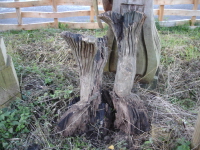 |
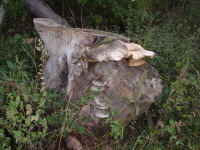 |
||||||||||||||||||||||||||||||||||||||||||||||||||||||||||||||||||||||||||||||||||||||||||||||||||||||||||||||||||||||||||||
Preservative
There are preservatives that are very potent, but they are not generally available to the public. Borate preservative, for instance, is available in solid rod form for placing in holes drilled into timber susceptible to damp and rot. Other metal salts can be used, even common salt can work to some extent, however their use is probably “off label” and should be approached with caution as a lot of them are very toxic in the environment and especially with regards to water. The old fashioned creosote worked very well as a wood preserver, it could also be directed to the middle of the base of a stump via holes drilled to the centre. Unfortunately no longer available to the consumer. Applying a “finish” to the sculpture will not usually stop it from rotting. Linseed oil finish will often be infested with black mildew in damp weather. Danish oil will need re-applying at least once a year if not more. Varnish is likely to degrade and separate from the timber under the influence of the sun and rain in 6months to a year. These types of finish can stop the rain from wetting a sculpture from the outside, so can reduce the possibility of rot that way. They will not prevent rot from attacking up through the base. They may also prevent the absorption of further coats of more effective wood preservative applied at a later date.
| |||||||||||||||||||||||||||||||||||||||||||||||||||||||||||||||||||||||||||||||||||||||||||||||||||||||||||||||||||||||||||||
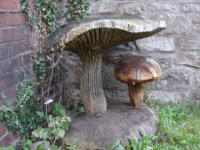 | 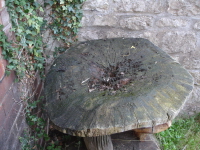 | ||||||||||||||||||||||||||||||||||||||||||||||||||||||||||||||||||||||||||||||||||||||||||||||||||||||||||||||||||||||||||||
Mushroom sculpture treated with creosote.
| Rotting out down the middle of the sculpture due to puddling
| ||||||||||||||||||||||||||||||||||||||||||||||||||||||||||||||||||||||||||||||||||||||||||||||||||||||||||||||||||||||||||||
So Which or What Treatment Works Best? If possible, have the sculpture carved from one of the naturally durable timbers. Make sure that all areas of the sculpture shed rainwater. It is a poor sculptor who does not design his carving to do just this. Puddles of water will rot out non-durable timber very quickly. If possible, keep the carving out of the sun and away from strong drying winds for a few months till it dries out slowly. If a non-durable timber stump has been carved, then its life may be extended by treating the part likely to rot first. This is normally the base of the trunk around 300-600mm above the ground. Holes can be bored around the trunk and inclining downwards towards the middle of the trunk (pattern similar to spokes on a wheel). These can be packed with a water soluble preservative (e.g. borate rods) or have preservative poured into them. They can then be plugged. This treatment can delay rot at this critical point for a few years, but will be unlikely to work on a hollow stump. If a sculpture is to be sited indoors, whether it be from a durable or non-durable timber, it will be liable to crack badly if it is recently carved. These carvings really need to acclimatise slowly by keeping them in unheated rooms or garages for a while till they dry out. If brought in straight away, they may crack badly (and quite loudly) in the course of a week or two. The treatment required with indoor carvings is that of treating the less durable timbers with a bit of woodworm preservative. The durable timbers are usually resistant to insect attack.
| |||||||||||||||||||||||||||||||||||||||||||||||||||||||||||||||||||||||||||||||||||||||||||||||||||||||||||||||||||||||||||||
|
The Natural Durability of Commonly Available UK Timber
Broadleaves
Conifers
Ref. BRE Laboratory Report. The Biological Natural Durability of Timber in Ground Contact by G.A. Smith and R.J. Orsler | |||||||||||||||||||||||||||||||||||||||||||||||||||||||||||||||||||||||||||||||||||||||||||||||||||||||||||||||||||||||||||||